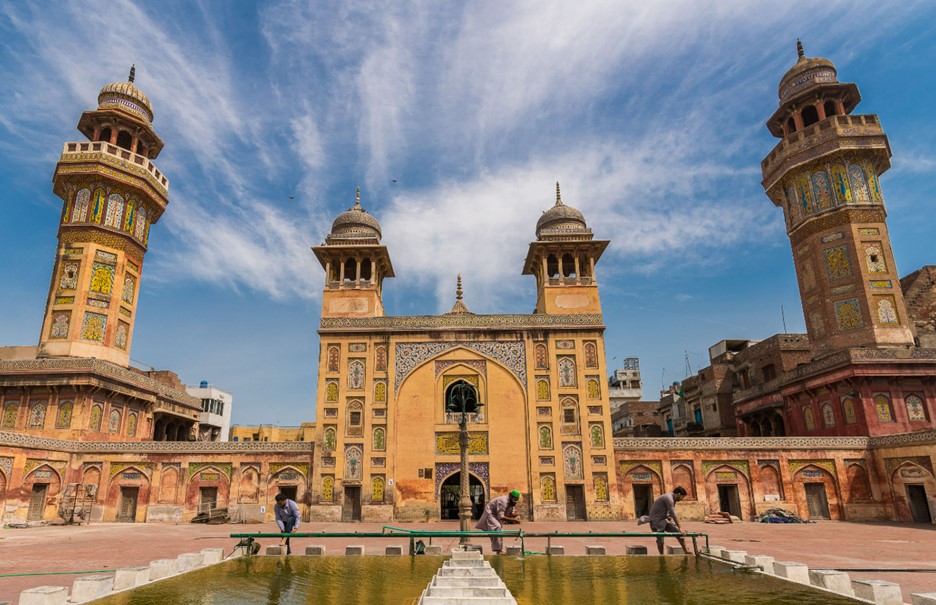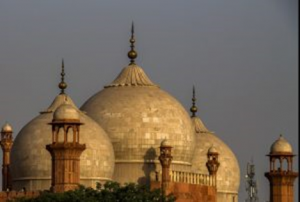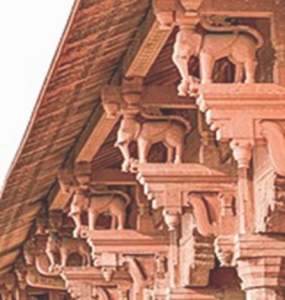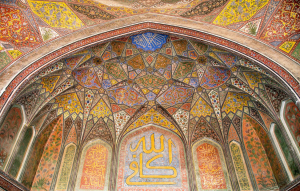Table of Contents
A Journey through Badshahi Mosque, Lahore Fort, and Wazir Khan Mosque
Make sure to visit these three historical and UNESCO heritage attractions in Lahore: the Badshahi Mosque, Lahore Fort, and Wazir Khan Mosque, to immerse yourself in the architectural splendors of the Mughal era. As these attractions are located in the inner city or walled city of Lahore, you’ll have the opportunity to delve into the authentic culture of Lahore. A nighttime visit to these places is highly recommended for experiencing the bustling food street, markets and the beautifully lit architecture of inner Lahore.
Why is the Badshahi Mosque a number one attraction in Lahore?
The Badshahi Mosque is considered the number one attraction in Lahore due to its architectural marvel, historical significance, religious importance, and stunning location.
A gigantic structure erected in the walled city speaks for itself, explaining why it’s an absolute must-see. Its sheer size and beauty are mesmerizing and awe-inspiring, particularly during the evenings or winter. The sight becomes even more magical on foggy evenings when the imam’s call for prayer in Arabic echoes through the air. Such an enchanting and spiritual moment leaves you spellbound.
Fun Facts About Badshahi Mosque
- The mosque is renowned for its grand size, featuring red sandstone with intricate marble inlays.
- Impressive calligraphy, executed by the renowned calligrapher Muhammad Hussain Tabatabaei, adorns the walls.
- With a capacity for over 100,000 worshipers, it is one of the largest mosques in the subcontinent.
- The mosque’s four tall minarets, reaching 176 feet (54 meters), add to its majestic appearance.
- Over the years, the mosque has been subject to various restoration and conservation efforts to preserve its original beauty.
- Badshahi Mosque holds historical significance, with notable events, including an address by Pakistan’s founder, Muhammad Ali Jinnah, in 1947.
- The mosque is beautifully illuminated during special occasions, creating a breathtaking sight for visitors.
- Beyond its religious importance, Badshahi Mosque is a popular tourist attraction, drawing thousands of visitors around the globe. It offers an opportunity to experience the rich history and architecture of the Mughal era, providing a serene and awe-inspiring atmosphere for both worshipers and tourists.
Address: Fort Rd, Walled City of Lahore, Lahore | Map |
Opening Hours: 8 am- 8 pm. The preferred time to visit is between 8 am and 12:30 pm, when the mosque is relatively empty, between the morning and afternoon prayers.
Average Summer temperature in Lahore: 30°C to 40°C (86°F to 104°F) +Humidity
Entry Information: Tickets are available on-site.
Note: Please refrain from wearing shorts; women are requested to cover their heads when entering the religious place.
Visit a nearby rooftop restaurant after your tour for some snacks and enjoy the fantastic view of the Badshahi Mosque, the Lahore Fort, and the old walled city from a bird’s-eye perspective.
Opening Hours: 8 am– 8 pm. The preferred time to visit is between 8 am and 12:30 pm, when the mosque is relatively empty, between the morning and afternoon prayers.
Badshahi Mosque- History and Architecture
One of Lahore’s most remarkable Mughal buildings is the Badshahi Mosque and Alamgir Gate. This majestic mosque, constructed by Emperor Aurangzeb in the 17th century (1671-1673), stands as one of the largest mosques in the world and the second largest in the Indian subcontinent.
The Taj Mahal in Agra and the Badshahi Mosque in Lahore are remarkable gems of Mughal architecture and artistic style. The architect of the Badshahi Mosque exemplifies the unique fusion of Islamic and local Indian architecture with its bulbous domes, cylindrical minarets, vaulted gateways, and expansive courtyards adorned with beautiful landscapes. Like their dynastic counterparts, Mughal architects sought to showcase their power through public displays, focusing on building structures such as Shahi Mosques, Mausoleums, Palaces, Gardens, and Fortresses.
Location
Positioned adjacent to the walled city of Lahore, the Badshahi Mosque faces the Alamgir Gate and overlooks the Lahore Fort. Notably, the tomb of Pakistan’s national poet, Allama Iqbal, renowned for his literary contributions in Urdu and Persian languages, lies near its entrance.
Structure and Layout
The mosque boasts three grand domes and eight minarets- four major and four minor, reaching a height of 226 ft 4.5 in (68.999 m). The spacious courtyard, spanning 276,000 square feet, can accommodate up to 100,000, while the prayer hall can hold 10,000 worshipers. During Eid, it serves as an Eidgah for offering Eid prayers.
The mosque’s distinctive characteristics include white and red colors, large bulbous domes, vaulted hallways, polylobed arches, minarets, and beautifully paved courtyards.
One of the most striking features of the Badshahi Mosque is its massive arched gateway with a projecting balcony at the main entrance. This gateway leads to the congregational hall, divided into three sections by arches supported by columns. The central section contains the mihrab, a cavity like a half dome, in the wall indicating the direction of Mecca, which Muslims should face when praying.
Façade and Material Used
Rather than a polished surface, intricate designs were carved into the stone, filled with white marble, showcasing both geometric and floral motifs, distinct from the traditional glazed tiles seen in other mosques like the Masjid Wazir Khan. The mihrab is a marble-carved stone that reflects the light and creates a serene atmosphere. Opposite the mihrab is the minbar, a raised platform where the imam (leader of the prayer) stands to deliver the sermon. The minibar is also marble and decorated with inlaid stones that form intricate patterns.
Above the vaulted entrance, visitors can find the full name of the mosque inscribed in marble as “Masjid Abdul Zafar Mohyuddin Mohammad Alamgir Badshah Ghazi.“

Renovations and Restorations
Over the years, the Badshahi Mosque has served various purposes. During Ranjit Singh’s rule (13 November 1780 – 27 June 1839), it was used as army stables. Later, his son, Sher Singh, adapted it for military purposes, utilizing the minarets to place light guns during the war with the British in 1841. In 1849, the British took control of the mosque from the Sikh empire and started restoration, which was completed in 1960 with contributions from Pakistan, Libya, Saudi Arabia, Kuwait, and UNESCO.
Lahore Fort- History Architecture and Intriguing Facts
Lahore Fort showcases stunning Mughal architecture, intricate designs, majestic gates, beautiful gardens, and exquisite marble work. The iconic Sheesh Mahal (Mirror Palace) within the Fort is a highlight, featuring intricate mirror mosaics that reflect the artistic brilliance of the Mughal era.
The Fort has witnessed the rule of various dynasties, including the Mughals, Sikhs, and British, leaving behind a diverse architectural legacy that fascinates visitors. Additionally, Fort’s well-preserved structures and ongoing restoration efforts make it a prime example of historical preservation in Pakistan, further adding to its significance as a top attraction in Lahore for locals and tourists alike.
Fun Facts About Lahore Fort
- Age and History: The Lahore Fort is believed to be over 1,000 years old, with its origins dating back to the 11th century during the reign of Mahmud of Ghazni. However, most of the present-day structures were constructed during the Mughal era.
- Inspiration for the Taj Mahal: It is said that the design of the Lahore Fort Sheesh Mahal (Mirror Palace) inspired the construction of the famous Taj Mahal in Agra, India.
- Underground Escape Routes: There is a network of underground escape routes and hidden passages used by the royals during war or emergencies.
- The Diwan-e-Aam: The Diwan-e-Aam, or Hall of Public Audience, is a majestic structure within the Fort where the Mughal emperors held public meetings and addressed their subjects.
- Elephant Path: There is a carved stone path inside the Fort called the “Elephant Path,” which was used by elephants to transport goods and royal dignitaries to different sections of the Fort.
- Legend of the Heera Mandi: Adjacent to the Lahore Fort is the Heera Mandi, a red-light district known for its traditional performing arts and entertainment during the Mughal era.
- British Influence: The Fort underwent significant changes during British rule, with the British adding various buildings and barracks for their soldiers.
- Preservation Efforts: Despite centuries of wear and tear, several sections of the Fort have been well-preserved and restored, thanks to continuous efforts by the international and local authorities.
- Film and TV Icon: The Lahore Fort is prominent in Augmented Reality (AR) experiences or media, including numerous Pakistani films and television dramas. Additionally, people often choose this location for wedding shoots in front of the Lahore Fort and the nearby Badshahi Mosque.
History and Architecture
A UNESCO-listed Marvel with Millennia of History
Lahore Fort and Shalimar Garden have been listed as UNESCO World Heritage Sites since 1981. The Lahore Fort has a history of habitation that spans millennia, originating as a mud-brick fort in the 11th century. A gold coin belonging to Mahmud Ghaznavi, 1025 CE, was found during excavation in 1959 beneath 25 feet of soil near the garden close to Diwan-i-Aam. According to ancient oral traditions, the Lahore Fort had a vacant temple dedicated in honor of Lava, a Hindu god. This proposition may be accurate based on excavation findings of terracotta depictions of mother goddesses, horses, bulls, and other figures of Hindu origin.
Mughal Emperor Akbar’s Lasting Imprint on the Fort
Lahore Fort was built by Akbar, a Mughal emperor, in the 16th century and later expanded and renovated by other Mughal emperors. The Fort has two sections. The administrative section includes the Diwan-e-Khas, Diwan-e-Aam, and a garden. At the same time, the residential area two is divided into two courts with Sheesh Mahal, spacious bedrooms, and small gardens.
During his reign, Akbar constructed numerous fortresses and palaces, and one notable achievement was replacing an old mud fort, destroyed by the Mongols, with a sturdy brick structure. He adorned these constructions with a blend of Islamic and Hindu art motifs. Some surviving structures from his time include Diwan-khas, Akbari Gate, and Jharokha Darshan. The Jharokha Darshan was a window from which Akbar would appear twice daily to meet and greet his administrators and the general public, attentively listening to their grievances and complaints
Jangir’s Artistic Flourishes: Enriching Lahore Fort’s Legacy
Jahangir (31 August 1569 – 28 October 1627) made significant additions to the Lahore Fort, including the Kala Burj pavilion, which exhibits European influences with its vaulted ceiling and Christian paintings of Madonna and Jesus. Another example of European influence can be seen in the “Picture Wall” he built, displaying numerous glazed tiles with paintings, similar to the Portuguese style of decorating churches with ceramic tiles during that era. The picture wall serves as a valuable source of insights into the daily activities, sports, hunting, and leisure pursuits of the Mughal courts, including a panel depicting four horses playing a Mongolian game known as Polo in modern times.
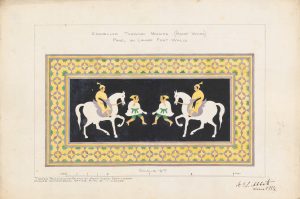
A replica of the enameled tile work from one of the “Picture Wall” arts in Lahore. Courtesy of the Punjab Archaeological Office in Lahore
Shah Jahan’s Majestic Enhancements: Reviving Lahore Fort’s Splendor
Shah Jahan (5 January 1592 – 22 January 1666) also contributed to the Fort’s building by rebuilding the Diwan-i-Aam. The Diwan-i-Aam, meaning “public audience hall,” was a Persian-style structure with 40 pillars.
Furthermore, Shah Jahan built the magnificent Sheesh Mahal, also known as the “Mirror Palace,” where candles were lit at night, enhancing the mesmerizing view of the mirrored interior. He also modified the Moti Masjid, built initially during Jahangir’s era, transforming it into Moti Gurdwara.
Beneath the Sheesh Mahal lies the Summer Palace, where the Mughals spent time during the hot summer months. The palace’s architecture, materials, and water use contributed to its cooling effect. The high roofs and numerous doors facilitated adequate cross ventilation, channeling cool breezes through the palace. The mud floor of the palace had two layers, with water from the nearby Ravi River pumped through it. This water was infused with the fragrance of rose petals and flowed throughout the palace and garden through cascades and waterfalls. Additionally, the garden in front of the Sheesh Mahal boasts numerous fountains, adding to the grandeur of the entire complex.
Alamgir Aurangzeb ( c. 1618 – 3 March 1707) constructed the captivating Alamgiri Gate, which imparts a majestic appearance to the Lahore Fort. This semi-circular dome-like structure has become an iconic symbol of the Fort’s grandeur.
Sikh Era Fort Expansion
During his rule, Ranjit Singh made several noteworthy additions to the Lahore Fort. He constructed a beautiful garden called Hazuri Bagh, and at its center, he built a remarkable structure known as Baradari, which features twelve doors supported by pillars. The ceiling of Baradari is adorned with intricate mirror mosaics, adding to its visual appeal. Additionally, the basement of Baradari includes living quarters.
Furthermore, Ranjit Singh utilized the Summer Palace as his residence, particularly during the summer when he sought relief from the heat. Additionally, he converted the Moti Masjid into a Sikh place of worship, known as Moti Gurdwara, reflecting his religious preferences during his reign.
Wazir Khan Mosque
Masjid Wazir Khan c. 1634-1641 is renowned for its intricate glazed tile work. It is considered one of the Mughal Era subcontinent architecture’s most embellished and detailed artworks.
The mosque is in the bustling heart of Lahore’s lively old city, enveloped by vibrant bazaars, narrow streets, and historical landmarks. This contributes to the area’s overall charm and ambiance. As you wander through the quaint streets of downtown old Lahore, you suddenly turn a corner, and there it stands, exuding its full majesty and tranquility.
Fun Facts About Wazir Khan Mosque
- Adjacent to the mosque is a historic Persian hammam (public bathhouse) that was built for the use of visitors and travelers. The hammam has a unique architectural design and reflects the communal hygienic practices of the time.
- An exciting feature of the mosque’s layout is incorporating a bazaar of 22 shops, the first ever discovered in any mosque’s plan. There are rows of shops along the mosque courtyard. The income from the shops and the hammam was used to cover the mosque’s expenses.
-
The mosque was a place of worship and served as a medical school during its early years. The renowned Hakim, Wazir Khan, believed that the ambiance of the mosque’s courtyard had healing powers.
Location
The mosque was erected on a vast tract of land extending from Delhi Gate in the east to Lahore Fort in the west. Historically, this place was an older shrine from the 13th century was dedicated to the Persian saint Syed Muhammad Ishaq, also known as Miran Badshah, who migrated to the subcontinent.
Address: Shahi Ghuzargah, Walled City of Lahore, Lahore | Map | Website
Opening Hours: 8 am– 8 pm. The preferred time to visit is between 8 am and 12:30 pm, when the mosque is relatively empty, between the morning and afternoon prayers.
Entry Information
Tickets are available on-site.
Note: Please refrain from wearing shorts; women should cover their heads when entering the religious place.
History and Architecture
Masjid Wazir Khan is located west of Delhi Gate in the ancient walled city of Lahore, Punjab. The route from Delhi Gate to Lahore Fort is known as Shahi Guzargah, meaning the “Royal Trail.” It is on the UNESO Tentative List. The mosque’s construction spanned seven years, from 1634 to 1641. Its architectural style is influenced by Arabic, Persian, and the Lodhi Dynasty, which was concurrent with contemporary Mughal Architecture.
During Shah Jahan’s reign, a prominent Mughal Court physician named Ilam-ud-din Ansari, also known as Wazir Khan, constructed several monuments in Lahore. Among the notable ones are Masjid Wazir Khan and Shahi Hamam. Wazir Khan hailed from Chiniot in the Jhang district of Punjab.
Structure and Materials
The overall style of the mosque is more like Iberian Moorish architecture found in places like Florence (Italy) and Spain, rather than the Mughal architecture that later emerged in the subcontinent.
Minarets grace each of its four corners, a design innovation first introduced in Lahore and later embraced by Mughal Emperor Aurangzeb for the Badshahi Mosque.
Unlike the bulbous domes of the Badshahi Mosque, the domes of Wazir Khan Mosque feature a Persian architectural style known as Chartaqi, characterized by its four arches. This style has origins that predate Islam, dating back approximately 1,500 years.
The mosque’s courtyard measures approximately 160 feet by 130 feet and is surrounded by high arches and galleries, reminiscent of the typical Persian imperial style. Within the courtyard lies a 35 by 35-foot pool used for Wudu, the Islamic cleansing ritual before prayer.
An arched niche at the mosque’s entrance showcases the first instance of muqarnas, a form of decorative plasterwork. This muqarna design is reminiscent of the Alhambra in Spain.
The entire floor of the mosque is constructed using dressed tiles laid in 13 distinct patterns. The original mosque floor remains preserved five feet below the current ground level.
Much of the construction materials used in the mosque reflect the typical Mughal era. Cut and dressed bricks (Bricks with a smooth and uniform size) were employed as the primary construction material, while glazed tile mosaics adorned the façade.
Tile Work
The tile work, known as Kashi Kari, follows the Persian style, showcasing vibrant colors, including cobalt blue, aqua green, white, orange, yellow, and purple. The intricate designs feature star-shaped and grapevine motifs, reflecting the influence of Persian aesthetics. Notably, the scale of Kashi Kari tile work employed in Wazir Khan Mosque is unparalleled in any other building from the Mughal era.
Calligraphy
Calligraphy
The entrance façade is adorned with intricate calligraphy featuring verses from the Quran and sayings of the Prophet Hadith. Sura Al-Baqarah verses are inscribed above the entrance of Iwan.
The right side of the iwan panel bears the inscription: “To all who turn towards the Qibla (Mecca) In supplication, may this door remain generously open with prosperity until the Day of Resurrection.”
On the left side of the iwan panel, the inscription reads: “Farmers! Whatever we plant in this world, we shall harvest in the next. Establish a solid foundation in this life. All individuals must traverse this gateway to reach Paradise.”
Frescoes Painting
The mosque’s interior features both the dome and walls adorned with frescoes, a painting technique involving the application of pigments mixed with water onto wet plaster.
